Climates dictate how five regional shops make enclosures
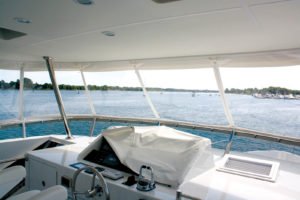
Many customers on the Great Lakes seek weather protection for their boats. Charles Klein, owner of Dorsal LLC, Sturgeon Bay, Wis., connected pieces of clear2sea™ to create window panels (removable and roll-up) for a full enclosure on a 72-ft. Ocean Alexander.
Local geography can define a business. In the case of marine fabrication shops, locality can factor into everything from work schedules to choice of materials. Whether the shops are based in the subtropical heat of Florida or the often-chilly climate of the Great Lakes, fabricators make sure their marine applications meet customers’ unique needs.
Honoring the local habits of boaters, regardless of where they live, is important when making enclosures. Fabricators need to understand where their customers’ vessels travel to and how long the boating season lasts. In turn, fabricators need to educate their customers on why certain materials are recommended and the best time frames and places to do the fabrication work.
Fabricators say that job number one in setting up shop is, “Listen to the locals,” according to Suzi Clinefelter, owner of Mystery Bay Sails and Canvas in Nordland, Wash. “I’d learn about how weather and water conditions dictate to the preferences and personal styles of that region’s customers.”
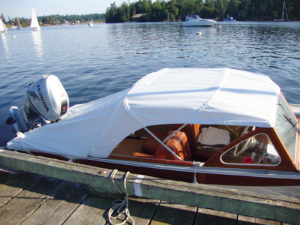
Suzi Clinefelter, owner of Mystery Bay Sails and Canvas in Nordland, Wash., says her customers deal with lots of precipitation and changeable microclimates, requiring flexible coverage and venting on boats.
Pacific Northwest
Think rain. “We get 24/7, soaked-to-the-bone rains for up to a week, and the sun does not shine until July 5. Don’t get too far away from your raincoat and sweater,” says Clinefelter. “And yet, we have many microclimates. In Seattle it could be 50 degrees and rain, but in the San Juan Islands, it could be sunny and 70.”
Sunbrella® is the standard, but she also uses WeatherMAX® and Top Gun® (highly water resistant). “I put Top Gun on a 34-foot trawler-style yacht, a classic with lots of varnish…we strategically place openings for venting.”
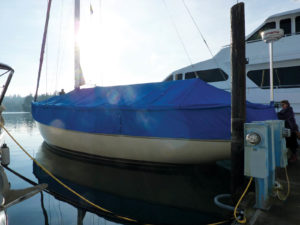
Mystery Bay Sails and Canvas, Nordland, Wash., fabricated a full enclosure for a climate that can be both benign and extremely rainy. This 50-ft. Kettenburgh Sloop has a full-mooring cover with removable side skirts, made with WeatherMAX®.
When she installs keders, it is with an appreciation that the track acts as a rain gutter, so water cannot seep through where snaps would otherwise be. For windows, Clinefelter prefers Strataglass™, a clear vinyl that does not twist out of shape or distort the view. She says this material is reliable, attractive and long lasting.
One advantage to the Pacific Northwest is no winter storage is needed. In the fall Clinefelter does boat cover patterns, which often require multiple fittings on the water. “Because of our more benign weather I can do patterns through the winter, watching for appropriate weather windows,” she says.
Southeast
Think shade. Sun protection is important, “and the more the better,” says Stephen Lippincott Jr., owner of Lippincott Marine Canvas in St. Petersburg, Fla. “It’s all about big deck awnings and big biminis, so that there’s lots of shade.”
Winter is mild in most of Florida, but it’s hot eight months of the year. “Toward the end of summer,” says Lippincott, “it’s so stinking hot you just stop boating, tie up, and go to the movies.”
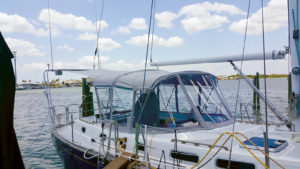
Stephen Lippincott Jr., owner of Lippincott Marine Canvas, in St. Petersburg, Fla., says he strives to position his fabricated panels well so they can be quickly opened and closed to accommodate the heat and rain experienced by his boat customers.
Nevertheless, Floridians experience some cool mornings and evenings in the summer and during those non-summer months. “You have to allow for flexibility with ventilation,” he says. “It can drop to 60 degrees and be cloudy, but then the sun pops out and it’s 90. You have to position panels well so that you can quickly open and close them, especially with the amount of rain we get.”
With corrosive saltwater and such sustained heat, “It’s a must to only use the best materials,” says Lippincott. “We use Sunbrella or Stamoid with lighter colors, and Tenara, a 10-year thread, made of PTFE [polytetrafluoroethylene] fibers. Back in the day, we used polyester thread that rots in Florida in three to four years. Using Tenara, customers have the peace of mind that they won’t worry about re-stitching that often.”
In creating openings, Lippincott strives for single-piece construction. He removes the center of one piece of material rather than sewing strips together; a single piece is stronger than a stitched one.
For tubing, Lippincott starts with 1-inch stainless steel, moves up to 1¼-inch on 10-ft. spans, and creates welded trusses for spans 15-foot and longer. Windows are 40-gauge vinyl, not 30-gauage. “There’s less distortion with the heavier gauge,” he says.
Northeast
Think short. Boaters have “a very short season of May through September,” says Richard Hallett, owner of Hallett Canvas & Sails Inc., in Falmouth, Maine. Instead of seeking shelter from the sun, usually boaters beg for the sun’s warmth. Enclosures are often for keeping in the heat, not keeping out the sun.
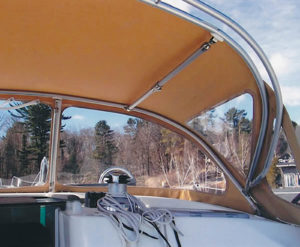
Richard Hallett, owner of Hallett Canvas Inc., Falmouth, Maine, explains that H2ube can be bent around a 4-in. radius and you can still feed canvas through the channels, thus eliminating the need for pockets and zippers to attach the canvas to the frame. Also, the material is tensioned along the length of the tubing, eliminating wrinkles.
“Customers are darn sure they want to be on the boat at the beginning of the season in May, so we’ve got a gun to our head in that initial rush to get products done when they’re ready,” he says. “We go with 8 to 10 employees working 14-hour days five days a week, and we have trouble getting help. If we take orders at boat shows in March and tell customers their boat will be ready in June—when the water is still only 51 degrees—they look at us like we’ve got three eggs on our head. They want their boat in April.”
After the season-opening push, the days are only eight to nine hours. “It gets easier, steadier,” says Hallett. “We’re busy all year round servicing canvas and sails, and cleaning in winter.”
Regarding service, Hallett often goes mobile, traveling up to an hour to reach boats off the many peninsulas of Maine’s coast. “There are few canvas shops up here,” he says, “so we put a sewing machine and materials into a van. We service big boats, 45- to 60-footers, and owners don’t want to truck them to the shop. We get on the water to get some of our patterns done. Once in a while boats will pass through from Massachusetts on their way to Canada. We’ll measure the pattern and finish the job when they are on their way back.”
Hallett has patented the H2ube, which is 7/8-, 1-, or 1¼-inch aluminum tubing with two 3/32-inch wide channels. With H2Ube, a common welt is sewn to the finished edge of the canvas. Special notches in the tube allow the welt to be inserted and slid through, reducing labor and materials and creating a smooth, clean look to a bimini or dodger.
West Coast
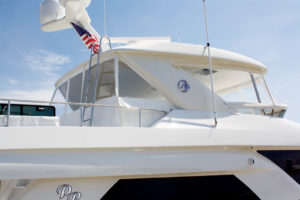
Charles Klein, owner of Dorsal LLC, Sturgeon Bay, Wis., says his customers deal with cold, bugs, sun, wind and spray, requiring a lot of protection during the region’s short boating season.
Think variety. “The San Francisco Bay is rough, cold and foggy, and boats take a beating on the saltwater,” says Jeff Viehmeyer, owner of Alameda Canvas in Alameda, Calif. “Boats go back and forth between the 50-degree bay and the freshwater delta of the Sacramento River and the San Joaquin River, where they could anchor in calm areas with an air temperature of 100 degrees. In the bay they have to keep things buttoned up, and in the delta it’s just the opposite. Also, we get boats going north to Canada, south to Mexico, and west to Hawaii and the South Seas.”
With such variety, creating patterns and making material decisions can be tricky. “Wind is never a friend of the canvas man,” says Viehmeyer. “Constant wind that blows hard in the bay hurts your patterns.
Fluttering wind is the same; you won’t get a precise, pulled-tight piece. And then if you’re going to be in hot, calm conditions of the delta, it may make sense to use fasteners to hold the panels together. But fasteners have gaps that spray gets through, which you don’t want if you transition to the bay.”
Great Lakes
Think indoor heating. “It’s a 12-week season, and there’s a time crunch to get boats on the water by Memorial Day. By July 4th, customers are desperate,” says Charles Klein, owner of Dorsal LLC in Sturgeon Bay, Wis. “All local marinas have indoor heating, and we train customers to do as much work as possible in the winter. I’d rather work indoors versus baking in summer heat as they do in Florida. With storage and upholstery work in the winter, we’re busy all year.”
Boating on the Great Lakes means dealing with “big water that leads to the East Coast and Newfoundland by way of the St. Lawrence Seaway and the Erie Canal,” says Klein. “You better pay attention when you venture out onto Lake Michigan, which has the cold, bugs, sun, wind, spray, you name it.” To satisfy customers seeking weather protection, he creates everything from dodgers to biminis to windows (removable and roll-up) for full enclosures on a 72-foot Ocean Alexander using clear2sea™.
“Sunbrella rules the roost,” he says. “We don’t bother to sell much else. With white, we’ll use Stamoid occasionally, but white tends to get dirty up here; we get a surprising amount of air pollution from Chicago and Milwaukee.”
Klein invested in digital technology 10 years ago. He says there was a learning curve with CNC (computer numerically controlled cutting machine), the Proliner 8 digitizer, and the Rhinoceros modeling program, but it has been worth the time and effort when replacing or making new canvas. He uses the system also to create cushion covers by setting up the digitizer inside the boat.
Klein likes the digital technology but admits to being “hesitant” about letting it rule his shop and possibly change his customer base. He doesn’t want to follow the ways of some cabinetmakers, for example, who switched to CNC and transitioned from creating high-end cabinets to mass producing the likes of “melamine cabinets for condominiums. The good news is this has not happened, and in fact CNC has expanded the scope and scale of our projects.”
Gary Legwold is a freelance writer from Minneapolis, Minn.
 TEXTILES.ORG
TEXTILES.ORG 






